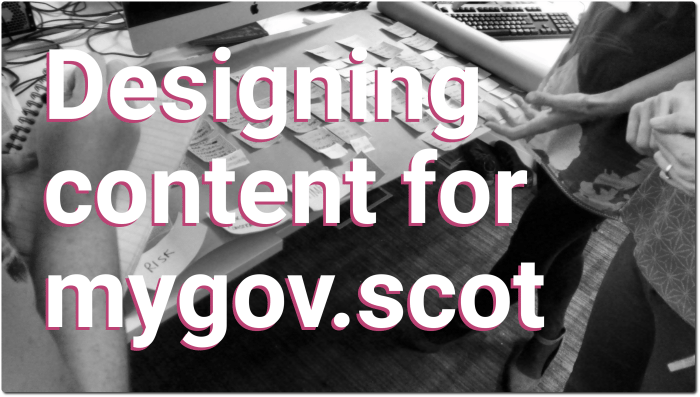Digital
Designing content for mygov.scot
October 6, 2015 by craigmilligan No Comments | Category Digital Public Services, mygov.scot
This is a post by Rachel Dowle, our Head of Content
In 2012, the Scottish Government set out its intention to deliver a “single – but not exclusive – point of entry to all digital public services at national and local level”.
So, what does that mean for how we design content on mygov.scot?
We want to make sure citizens don’t need to think about organisations to deal with their complex needs.
We can assume users often don’t know who provides a service – whether it’s provided at a UK reserved level, devolved to Scotland or administered by local councils.
As a user, you might:
- know what you’re looking for and need to complete a specific task (often involving a transactional element like ‘I want to pay my council tax’)
- know what you’re looking for, but this requires multiple services and organisations (for example dealing with a change to your financial circumstances)
- have a need but don’t know how to resolve it (for example dealing with debt)
- be at crisis point and have no idea how to deal with it (dealing with abuse)
For the first 2 examples, we’ll help users make informed decisions. By building authority and trust, mygov.scot will become a single point of entry.
We’ll make information as accessible as possible and streamline the process to deliver the ask citizens have of government.
However, delivering for users who have much more complex needs is where we can really demonstrate value.
To do this we have to spend time researching complex needs from the perspective of users before we consider where service providers fit in. Looking at lives and life events allows us to conduct our discovery phase without limiting our view to organisation or sector. This also allows us to validate our understanding with real users.
We work with subject matter experts to understand the technical elements of a service (such as eligibility criteria – what you need to be able to apply for something) and make sure we describe information in plain English. We peer review content to make sure it’s accessible to everyone and it’s fact checked and reviewed for accuracy by service providers.
Our challenge over the next delivery phase on mygov.scot is to find new ways of co-designing content with real users, so we can test any assumptions we are making about how to present the information. For example, what does a victim of domestic abuse need in terms of support when reporting a crime? We partnered with Scottish Women’s Aid when producing content to get that perspective.
We recognise that needs aren’t always best met by the public sector – and that digital isn’t always the answer – so we signpost to trusted sources of advice, including third sector organisations like Shelter or Citizens Advice.
To make the experience as seamless as possible, we produce and maintain ‘managed journeys’, which must always work for the end user. Delivering for users does not always mean producing more content.
Feedback is an important part of our content lifecycle to make sure we constantly improve the user experience. We’ll continue to test the website with real users through usability sessions, and encourage feedback on every page.
Please continue to give us feedback and help shape our future content on mygov.scot.
Follow the team via @mygovscot on Twitter for more updates. Please leave comments below, we’d love to hear from you.
Tags: content


Leave a comment